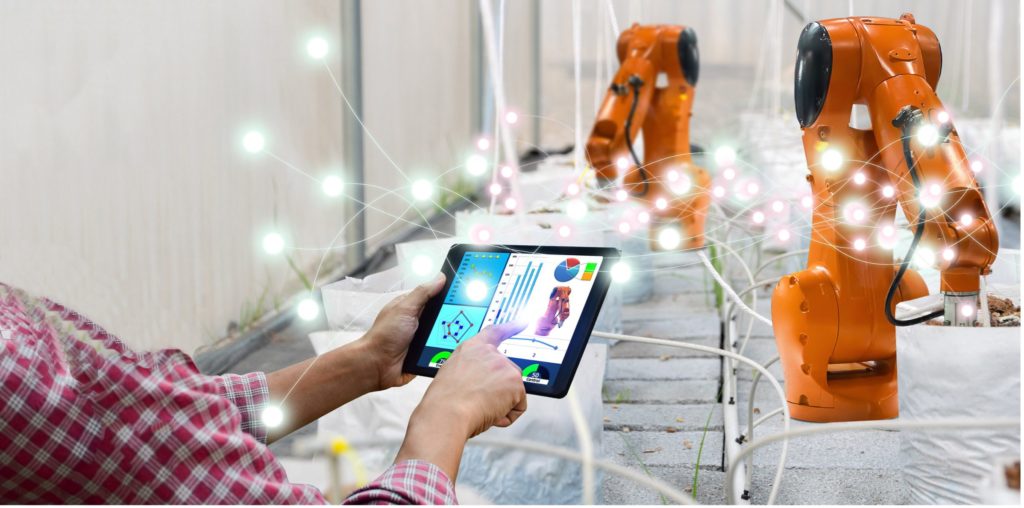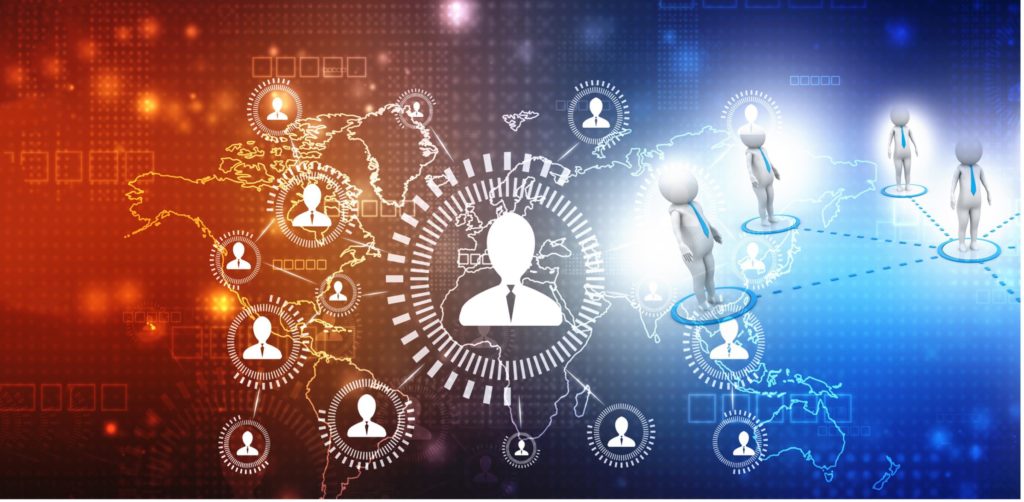Paul and Nancy’s 2022 predictions for the digital workplace

So, this is my seventh year of doing my best to predict the next 12 months for the digital workplace industry. It is always an intriguing experience gathering together potential predictions throughout the year to then decide towards the end of it which ones will have enduring value and influence for the year to come.
I like to include a mixture of aspects of the digital workplace to demonstrate the variety of ways in which HR, technology, future of work, devices, facilities and people are shaped by the ever-evolving digital world of work. It was gratifying to see that when the physical workplace shut down globally at such short notice in early 2020, the digital workplace was ready, waiting and fully capable to keep work happening. Suddenly, when COVID-19 arrived, the digital workplace moved from being ‘really important’ pre pandemic to becoming the ‘essential workplace’.
Back in 2014, I decided to include a review of how I had actually performed; taking a look back and scoring (albeit self-assessed) the year past, was important to me. Why read and listen to anyone’s predictions if they have no track record of success? In my case, I’ve been moderately accurate in my annual predictions to date and I’ll settle for that.
Now, with my wonderful colleague Nancy Goebel recently having taken over as host of Digital Workplace Group’s podcast Digital Workplace Impact, it felt a natural transition for Nancy also to pick up making DWG’s annual digital workplace predictions. But, rather than drop her straight in at the deep end of this world of forecasting, we decided to share the task for 2022 before Nancy goes solo on it next year.
2021 predictions scorecard.
So here is my review of how I did in 2021, followed by our joint predictions for the digital workplace in 2022.
| Prediction 1 | Cost cutting: the days of financial austerity (for intranets and the wider digital workplace) return for hard-hit economic sectors. | ✓ |
|---|---|---|
| Prediction 2 | Learning and Development ramps up to improve digital literacy, innovation and new ways of working for a changed (and still unfamiliar) working environment and economy. | ✓ |
| Prediction 3 | Leaders extend empathy, using digital spaces to listen to and engage with a widely distributed workforce, strengthening their cultures. | ✓ |
| Prediction 4 | Knowledge Management takes centre stage yet again – as part of the ongoing adaptation to working in distributed and hybrid ways of working, accelerated by the global pandemic. | ✓ |
| Prediction 5 | Enterprise technology providers innovate to free organizations from some of the constraints caused by the relentless rise of Microsoft. | ✓ |
| Prediction 6 | Virtual, augmented and mixed reality online meetings enable new experiences of emotional connection. | ✗ |
| Prediction 7 | Frontline and customer-facing workers finally enjoy the digital acceleration they always deserved. | ✓ |
| Prediction 8 | Workplace analytics and behavioural insights are harnessed to help manage digital fatigue, wellbeing and workplace health. | ✓ |
| Prediction 9 | Physical workplaces make a welcome return but local workplace ‘pods’ gain popularity as alternatives to working from home – while the digital workplace takes centre stage as the essential workplace. | ✓ |
| Prediction 10 | Large organizations open new ‘Digital Headquarters’ where all are welcome. | ✓ |
How does this compare?
Well, here’s what the story has looked like over the years…
Note, these are all self-scored but then cross-checked with a selection of digital workplace practitioners.
2014: 7/10
2015: 7/10
2016: 8/10
2017: 7/10
2018: 8.5/10
2019: 7/10
2020: 6/10
So, my performance for 2021 at 7.5 out of 10 lets me breathe a sigh of relief! 2020 was definitely an anomaly tied to the unprecedented circumstances ensuing from the pandemic. The digital workplace has emerged as the essential workplace as part of the move into the Decade of Courage.
Our look ahead to 2022.
And so now, for the first time, here is the joint set of predictions prepared by Nancy and me.
1. Dynamic working will pave the way for a new breed of hybrid leaders.
The ‘Decade of Courage’ calls for a new breed of leadership. 2022 will be the year when hybrid leadership comes of age. This is both a necessity and a call to action as a new normal emerges – one that is grounded by rolling changes that are affecting how, when and why work gets done, and by whom, from moment to moment.
Among the core characteristics such leaders demonstrate include:
- Authenticity: Now, more than ever, leaders are being called upon to show vulnerability, transparency, integrity and ethical behaviour. This is a way of inspiring trust amidst uncertainty, high stress levels and other challenges to the mental and emotional wellbeing of colleagues. Authentic leaders also foster open sharing and actively invite input from others to drive progress and impact.
- Empathy: Leading with heart, self-awareness, active listening and understanding has also taken on importance as individuals struggle to balance the new demands of work–life integration, flexible business agendas, and more. Leading by example and sharing the why behind things is a powerful motivator and enabler when colleagues are facing rolling challenges and changes.
- Ambiguity: The pace of change only continues to gain momentum, requiring leaders with a high tolerance for changing circumstances – ones who ask questions, spot emerging patterns, encourage exploratory thinking and seek unexpected results. Employees around such leaders will be more engaged, collaborative and innovative in their work.
- Decisiveness: The most successful and impactful leaders will thrive at making decisions with speed and focus, using a mix of intuition, experience, input and a minimum of data. Employees under such leaders will operate with clarity, context and purpose.
- Agility: Leaders are now continually called upon to adapt to an ever-changing and uncertain environment. Those who thrive most are continuous learners and have a growth mindset. They facilitate an environment where people and teams grow, work together, laugh and have fun, build trust, and do exceptional things to drive impact and value.

2. The physical world of work will remain in a midlife crisis.
Who would have thought that coming out of the pandemic and into the endemic era, it would be the physical workplace that would struggle – while the digital workplace has carried on going from strength to strength?
During the worst of COVID-19, work was simple in many ways. Those who could, worked from home, using the digital connections to stay productive and engaged. There were no choices, as non-essential in-person working was prohibited. But, in 2021, at every turn, the return to physical co-working has been mired in confusion.
The most extreme examples have been major Wall Street banks who mandated staff to get back to Manhattan, only to have to perform 180-degree switches when either the virus or employees refused to ‘obey’ orders. Then, at the other end of the scale, there were the tech brands who told everyone to ‘work wherever you want for ever’ – only to find that staff then felt homeless and colleague-less.
In 2022, this crisis of confidence in how to work together physically will continue – until employers decide what is required. Our own belief is that the ‘do your own thing forever’ approach will fail and that some level of dictating is needed. Teams need (where feasible) to be together physically at times, even if it is only once a week, a month or every 3 months, and a more assertive approach will arrive to retrieve physical co-work from a midlife crisis.

3. Innovation will be revitalized by citizen developers.
Several years ago, we saw a myriad of digital workplace teams experimenting with hackathons as a way of tapping the wisdom of the workforce and unlocking the power of ideation. Examples of this were highlighted in DWG’s research entitled How the digital workplace facilitates innovation.
With many organizations now opting for low-code/no-code solutions to develop enterprise apps, the ranks of citizen developers are re-emerging. These are digitally minded employees with little to no coding experience who create business applications and/or workflow solutions. Why now? The ongoing developer shortage, coupled with limitless demands for IT support, is causing enterprise software vendors like Microsoft, SAP and ServiceNow to double down on this alternate resourcing strategy.
Take, for example, Medtronic, a medical technology, services and solutions company, with 90,000+ employees globally. Medtronic launched a citizen developer programme in 2018 as part of a strategic move to ServiceNow. Today, a team of 25 account for 44% of all changes across the three ServiceNow production instances within the company. What seems like a small team on the surface is achieving development throughput increased by 56%, according to Lori Breitbarth, a senior IT programme manager at Medtronic.1
What to watch for? The move towards more citizen developers will pose a strain on digital workplace governance. Consider developing an in-house certification programme to guide developers to deliver their personal best while supporting wider efforts to achieve a more unified, personalized and integrated employee experience. Create communities of practice to support sharing knowledge, good practice and expertise; and create a network of peers that bring together citizen and pro-developers. Finally, consider where pro-developers need to step in to help manage risk and complexity.

4. Digital connections will foster meaning and belonging – to help spur recruitment and retention
The ‘Great Resignation’ – so expertly described by McKinsey in September 2021 in their article Great Attrition or Great Attraction2 – has understandably been preoccupying companies and sectors throughout 2021.
What the McKinsey research shows is that the main reasons why people have left, or are planning to leave, their current employers are relational. They want more value and purpose in their work and crave a deeper sense of belonging and connection. Employers in contrast have been responding with transactional rather than relational approaches; better pay, more flexibility and enhanced rewards.
After the failure of transactional responses, 2022 will see employers focus more on the relational factors. Generating deeper connections and a collective sense of meaning and value will help specific companies, and even industry sectors, to recruit and then retain the best people. In the book Nature of Work – The new story of work for a living age, by Paul Miller and Shimrit Janes, one chapter covers ‘Migration’ and this natural element applied to work will allow organizations to view the Great Resignation as the ‘Great Migration’, where human beings (like any species) seek to migrate to where they feel most at home at any one time.
About 30% of employees are considering leaving their jobs without any alternate work lined up. But in time they will find their better place to work, having migrated to a way of working and living that best suits them. One resource that companies can easily deploy is enhanced digital collaboration tools, both synchronous (such as Teams) and asynchronous (such as Teams again in fact) to foster deeper connections between team members and regions. One senior leader at security software firm McAfee routinely has one-to-one calls with all the 120 people in her global unit and praises this experience as far superior to a time when she was constantly flying around the world for meetings.
Organizations have long struggled to make data available in meaningful and actionable ways that are targeted to managers and employees.

5. Business intelligence (BI) will finally have its coming of age in the digital workplace.
Earlier this year, Microsoft introduced Insights as part of the rollout of the Viva suite of applications. The thinking behind this is that it will help people and businesses to thrive by using data-driven, privacy-protected insights and recommendations to improve productivity and wellbeing. Microsoft is positioning Viva Insights as a tool to help improve productivity and wellbeing through data-driven insights and recommended actions that help people to build better work habits.3
Early adopters, like Lumen, have already reimagined their end-to-end sales process by placing real-time analytics into the hands of sales leadership and their teams. They have gone on to use Insights to: uncover and replicate the best practices of their top performers; provide effective manager coaching; and drive sales excellence by improving productivity and wellbeing.
Powerhouse consultancies like Avanade, EY and PwC have publicly rallied behind Viva Insights, assuring that this toolset will become pervasive within organizations across the globe. Equally importantly, the Microsoft effect around BI will spark challengers, which will help to accelerate innovation from niche providers such as AVI-SPL Symphony, Acuvate and SWOOP Analytics.
To help their organizations leverage these capabilities, digital workplace teams need to understand how to forge the right partnerships, formulate the vision and bring together the plan to deliver BI tools to managers and employees.

6. Advanced digital workplaces become critical infrastructure, ready for the ‘next disruption’ to work.
Pre pandemic the digital workplace for one global bank was considered ‘really important’, while for another it was regarded as the future home for all employees. When COVID-19 arrived, the first bank struggled and then eventually adapted to life without offices, but this was painful and challenging; meanwhile, the second bank experienced a natural process, allowing it quickly to focus on customer support and care. Investments made in previous years bore fruit in ways that could never have been predicted.
The experience of the pandemic has flipped the digital world of work from ‘nice to have’ to ‘essential’ and, as life and work find their rhythm again, the digital workplace now occupies that essential role in work; an insurance policy to protect every company against future events. What was once considered just important, will now forever become part of the critical systems of any company.

7. Microsoft Viva will be the best thing since sliced bread in the ‘hybrid culture wars’.
During the height of the pandemic, employees discovered their collective voices, whether in demanding employer intervention in social justice causes or employer flexibility around how and where work gets done. Just look at the employee backlash that ensued when the likes of Apple and Google called for a massive return to the office some months ago, ditto for various financial services giants. These were early examples of the culture wars at work.
As we emerge into the endemic age, the conflict continues between the Old Guard, calling for the return to the office-centric status quo, versus the Vanguard, diving headfirst into the hybrid workplace.4 Where the Old Guard has traditionally led through command and control by walking around, the new breed of the Vanguard favours putting insights and intelligence into the hands of self-directed, self-motivated individuals and teams, who are results-driven for getting things done while having constructive dialogue about it.
Technology suites like Microsoft Viva are poised to accelerate a fundamental cultural shift that puts employees at the centre, empowers them and makes them accountable for individual and collective successes by bringing together communications, knowledge, learning, resources and insights into the flow of work of people and teams.
And, as the likes of Microsoft Viva and other employee experience suites mature and take hold, employees will become ever-more confident thinkers, life-long learners, doers, challengers and advocates for the Vanguard.

8. Future of Work units find their feet, spanning digital, HR, facilities and strategy
Work itself has been under the microscope in the last two years and, going into 2022, increasingly someone, or maybe a small empowered team, will be responsible for designing and enabling the future ways of working for any organization. Directors of Remote or Hybrid Working are new roles that have appeared in 2020 and 2021, but the whole field of what works means and looks like in the coming years is now spinning up new teams and units dedicated to thinking through not only where people will work but also how.
Fidelity Investments, the US-based financial services firm, has been growing its digital workplace practice area in this mode, incorporating a range of skills that span technology, strategy, innovation and experience. The opportunities for digital workplace practitioners and teams to imagine and embrace a broader future of work role will appear in 2022 and the most innovative leaders will seize this moment.

9. Networked learning will become a 4D experience in the digital workplace
In episode 87 of Digital Workplace Impact, we heard from Neeru Arora, CIO at Volkswagen, about the importance of building a culture of life-long learners as an anchor tenant of leading with the head, heart and hands. Neeru is just one example of a new brand of hybrid leaders who are talking about the importance of investing in ongoing development to enable themselves and their organizations to thrive and grow.
Of course, Microsoft has introduced Viva Learning as a centralized learning hub in Microsoft Teams; however, what it lacks is a holistic framework for modern learning. Content libraries are just one facet of learning inside organizations. The pressure is now on for digital workplace teams to deliver modern learning as a 4D experience5 for leaders, individuals and teams alike.
What are the 4Ds? Quite simply, they are about learning through…
- Discovery: When people find out things for themselves (think about the importance of findability in your digital workplace whether via enterprise search or AI and chatbots).
- Discourse: When people learn by interacting with others (think about the role of MS Yammer or Workplace from Facebook in unlocking powerful conversations).
- Doing: When people learn from their everyday experiences (think about the importance of workflow and automation tools like ServiceNow and WorkDay, along with collaboration spaces that support working out loud, like MS Teams).
- Didactics: When people learn from being taught or trained (think about your formal learning management systems along with knowledge-sharing videos on your internal YouTube channels).
Creating a culture of learning does not happen overnight. It takes a mix of capabilities that unlock networked learning as a 4D experience, along with a passionate advocate. Thankfully, there are many living examples to draw upon nowadays. Take smart organizations like Nokia, which breathed life into modern learning as a business imperative through its then Chair, Risto Siilasmaa, setting off on a self-motivated journey to better himself and improve his individual understanding of a tricky topic: machine learning. In the process, he shared what he knew, inspired his colleagues to examine their own knowledge gaps and triggered a network effect, launching waves of learning across Nokia that even spread far beyond the borders of the organization.6

10. Knowledge Management takes centre stage (again), combating the exodus of insight caused by the Great Resignation/Great Migration
Recently, I heard from three senior people across different sectors that they are leaving to take up new roles. These individuals have been with their well-known employers for 12, 16 and 21 years, respectively – and none of them is (in my mind at least) particularly old. They have all spent a large part of their career with one organization and are examples of the much-discussed Great Resignation referenced in our forth prediction.
The loss of all the know-how and wide connections these three bring to their organizations is hard to estimate. And yet, across all sectors, regions and companies, huge swathes of knowledge are evaporating – and many organizations are rightly scared at what is being lost. One global manufacturer is addressing this directly by reviving an already fairly robust KM approach, looking to have new hires overlap with the leavers for knowledge transfer, and using digital tools that allow for far more than just exit interviews but rather ways of curating individual or team intelligence.
One large physical workplace provider has a culture founded in Slack; new hires are asked to spend their first few days just trawling Slack to learn about the company. Then, armed with that knowledge and sense of network, they get to meet their colleagues feeling far more in the picture.
KM will have another sustained investment phase as companies use existing and new technologies to ensure that as much knowledge stays within the organization, by creating robust processes and habits that capture insights in real time.

A super prediction for 2022.
Advanced digital workplaces connect large workforces ensuring resilience against the unexpected
The pandemic transformed the digital workplace from being important to essential, the critical infrastructure of work. Offices might have closed but work continued mostly in the digital worlds of work that had been growing steadily for the past 30 years.
For some organizations, COVID-19 lockdowns revealed how well prepared they were but many others found out how much they needed to scramble just to become functional. Companies like to learn from mistakes once – and getting caught without a robust digital workplace is an experience not to repeat. So, for 2022, the super prediction is not one saturated in pioneer thinking but a rather more down-to-earth restating that the digital workplace will be the insurance policy every company needs against whatever will come next (both expected and unexpected).

——————————
1 Richard McGill Murphy. Ordinary people, extraordinary apps. Forbes, Feb 21, 2021
(www.forbes.com/sites/servicenow/2021/02/26/ordinary-people-extraordinary-apps).
2 Aaron de Smet et al. ‘Great Attrition’ or ‘Great Attraction’? The choice is yours. McKinsey & Company, Sep 8, 2021 (www.mckinsey.com/business-functions/people-and-organizational-performance/our-insights/great-attrition-or-great-attraction-the-choice-is-yours).
3 Microsoft Workplace Insights. Microsoft, 2021 (workplaceinsights.microsoft.com).
4 A survival guide for the upcoming hybrid workplace culture war – 5 deadly traps to avoid. Future Worx, 2021 (www.futureworx.io/survival-guide-for-the-hybrid-workplace-culture-war/).
5 The 4D’s of Learning. Modern Workplace Learning, 2021 (www.modernworkplacelearning.com/cild/mwl/5-features-of-ow-modern-professionals-learn/).
6 Josh Bersin. CEO and L&D: How the C-suite can foster a culture of learning. Josh Bersin Academy, Nov 16, 2021 (bersinacademy.com/blog/2021/11/ceo-and-learning-and-development).
Categorised in: → DWG Predictions, Digital workplace, Digital workplace trends, Future of work
